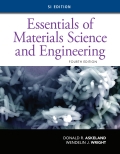
(a)
Interpretation:
The amount of cold work for each of the given steps should be determined.
Concept Introduction:
The relationship between cold work and area is:
Answer to Problem 8.26P
Value of cold working for the diameter ranging from
Value of cold working for the diameter ranging between is
Explanation of Solution
Given information:
Steel bar having initial diameter of 25-mm is cold extruded to 22 mm, and then from 22 mm to a final diameter of 20 mm.
Initial diameter
Final diameter
The value of area is:
On substituting the value of area in the above formula of percentage cold working:
Now on substituting the value of initial diameter and final diameter:
If the diameter is changing from
The above equation gives dependency of diameter value on cold work
Initial Diameter
Final Diameter
The values of area based on diameter is:
On substituting the values in terms of diameter:
(b)
Interpretation:
The comparison between the amounts of cold work for each step to the amount of cold work for direct conversion from 25 mm to 20 mm should be done.
Explanation of Solution
Given information:
Diameter is changing from
Steel bar having initial diameter of 25-mm is cold extruded to 22 mm, and then from 22 mm to a final diameter of 20 mm.
Cold work is the measure of degree of deformation and its calculation is done based on the original and final value area and according to the below statement cold work is directly proportional to the change in area:
The above formula to be used for the calculation of percent cold working as given in the question the value of initial diameter that is
Initial Diameter
Final Diameter
On inserting the values of initial and final diameter we have
Taking
On solving and taking square:
The value of cold work is
As calculated in the above part
Value of cold working for the diameter ranging from
Value of cold working for the diameter ranging between is
Sum ofthe cold work of diameter ranging from
Sum of the cold work of diameter ranging from
The amount of cold work is more for diameter ranging from
Want to see more full solutions like this?
Chapter 8 Solutions
Essentials of Materials Science and Engineering, SI Edition
- Can you please do with hand calcs and answer the following: a Determine the global stiffness matrix (K) of the beam including indicating correct degrees-of freedom (dof) b i) Calculate vectors D and Q ii) Show partition and solve KD=Q for D iii) Calculate all reactions c BMD & max BM, deflected shape d i) Solve the problem using Strand7 (model) ii) Display the deflected shape and BMD e Comparisons of reactions + Max BM including commentsarrow_forward(Read image)arrow_forwardI want to solve 13.2 using matlab please helparrow_forward
- a) Show a possible trace of the OSPF algorithm for computing the routing table in Router 2 forthis network.b) Show the messages used by RIP to compute routing tables.arrow_forwardUNIVERSIDAD NACIONAL DE SAN ANTONIO ABAD DEL CUSCO PRIMER EXAMEN PARCIAL DE MECÁNICA DE FLUIDOS I ............ Cusco, 23 de setiembre de 2024 AP. Y NOMBRES: ........ 1.- Para el tanque de la figura: a) Calcule la profundidad de la hidrolina si la profundidad del agua es de 2.8 m y el medidor del fondo del tanque da una lectura de 52.3kPa. b) Calcule la profundidad del agua si la profundidad de la hidrolina es 6.90 m y el medidor de la parte inferior del tanque registra una lectura de 125.3 kPa. Hidrolina Sp=0.90 Abertura Agua sup suge to but amulor quit y 2.- Calcule la magnitud de la fuerza resultante sobre el área A-B y la ubicación del centro de presión. Señale la fuerza resultante sobre el área y dimensione su ubicación con claridad. 3.5 ft 12 in: Oil (38-0.93) 14 in 8 inarrow_forwardusing r language to answer question 4 Question 4: Obtain a 95% standard normal bootstrap confidence interval, a 95% basic bootstrap confidence interval, and a percentile confidence interval for the ρb12 in Question 3.arrow_forward
- 5-1. Determine the force in each member of the truss, and state if the members are in tension or compression.arrow_forwardI have the correct answer provided, just lookng for a more detailed breadown of how the answer was obtained thanks.arrow_forwardfrom this problem a want you to help to draw the shear moment and the bending momentarrow_forward
 MATLAB: An Introduction with ApplicationsEngineeringISBN:9781119256830Author:Amos GilatPublisher:John Wiley & Sons Inc
MATLAB: An Introduction with ApplicationsEngineeringISBN:9781119256830Author:Amos GilatPublisher:John Wiley & Sons Inc Essentials Of Materials Science And EngineeringEngineeringISBN:9781337385497Author:WRIGHT, Wendelin J.Publisher:Cengage,
Essentials Of Materials Science And EngineeringEngineeringISBN:9781337385497Author:WRIGHT, Wendelin J.Publisher:Cengage, Industrial Motor ControlEngineeringISBN:9781133691808Author:Stephen HermanPublisher:Cengage Learning
Industrial Motor ControlEngineeringISBN:9781133691808Author:Stephen HermanPublisher:Cengage Learning Basics Of Engineering EconomyEngineeringISBN:9780073376356Author:Leland Blank, Anthony TarquinPublisher:MCGRAW-HILL HIGHER EDUCATION
Basics Of Engineering EconomyEngineeringISBN:9780073376356Author:Leland Blank, Anthony TarquinPublisher:MCGRAW-HILL HIGHER EDUCATION Structural Steel Design (6th Edition)EngineeringISBN:9780134589657Author:Jack C. McCormac, Stephen F. CsernakPublisher:PEARSON
Structural Steel Design (6th Edition)EngineeringISBN:9780134589657Author:Jack C. McCormac, Stephen F. CsernakPublisher:PEARSON Fundamentals of Materials Science and Engineering...EngineeringISBN:9781119175483Author:William D. Callister Jr., David G. RethwischPublisher:WILEY
Fundamentals of Materials Science and Engineering...EngineeringISBN:9781119175483Author:William D. Callister Jr., David G. RethwischPublisher:WILEY





